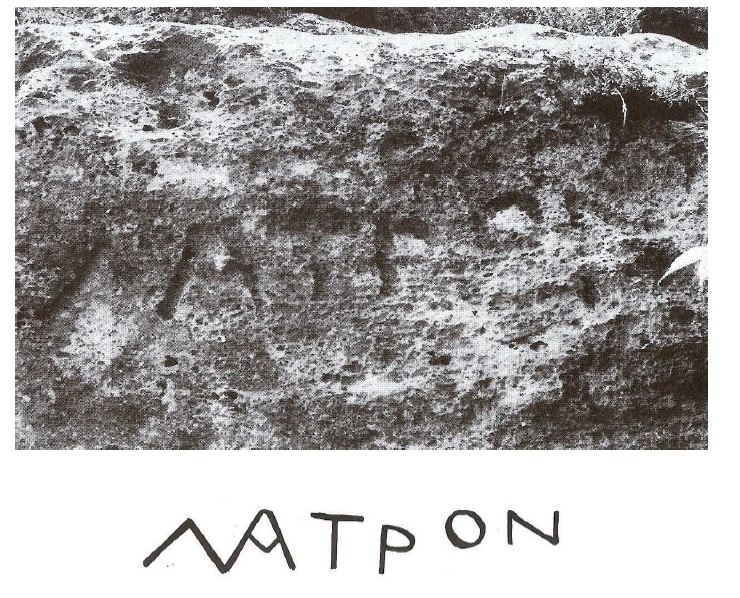C) Matron (‘belonging to the Mother Goddesses’): Istres
Finally, the genitive plural form matron, signifying ‘of the Mothers’, ‘belonging to the Mothers’, appears on a Gallo-Greek rupestral* inscription from the oppidum* of Castellan, a rocky hill overhanging the pond of the Olivier, near Istres (Bouches-du-Rhône). The site was inhabited from the 8th c. BC to the Early Middle Ages.121 The inscription is deeply engraved on a rock face, 2.4m from the ground, on the east side of the hill: ματρον (fig. 4).122 This rupestral* inscription, probably dating from the 2nd or 1st c. BC, is quite impressive, since its letters are about 20cm high.
In the middle of the 20th c., Fernand Benoit went in search of votive material evidencing a place of open-air devotion to the Mothers, and carried out excavations at the bottom of this rock face, but to no avail.123 According to Lejeune, the possibility of finding religious buildings dedicated to those deities in the area is hopeless, for the devotion must have been rendered directly to the natural element embodied and protected by the Mothers: the rock.124 Indeed, the inscription, in the genitive form ‘of the Mothers’, clearly indicates that the hill of Castellan was the property of the Mothers. Moreover, the fact that the inscription was directly made on the rock face must signify that the Mothers in some way personified the hill itself. Their function must have been the protection of what was in their possession, that is the hill, and by extension, of the people living on that mount.

These Gallo-Greek inscriptions from Nîmes, Glanum and Istres are of great interest because they reveal the worship of divine Mothers and are in the Gaulish language, which means they were written by Gaulish people, and date from between the 3rd c. BC and the 1st c. AD - the ones from Narbonese Gaul being the most ancient ones.125With the Plomb du Larzac, they also provide evidence of the existence of the word ‘mother’ in the Gaulish language, revealing its form and some of its declensions:126
| nom. sing. | mātīr, ‘mother’ (Larzac) |
| acc. sing. | materem (?), ‘mother’ (Larzac) |
| gen. sing. | (?) |
| dat. sing. | (?) |
| nom. plur. | (?) |
| acc. plur. | (?) |
| gen. plur. | ματρον (matron), ‘belonging to the mothers’ (Istres) |
| dat. plur. |
ματρεβο (matrebo), ‘to the mothers’ (Glanum, Nîmes) ατρεβο (atrebo), ‘To the fathers’ (Plumergat) |
The most significant example is the rupestral* inscription from Istres, in the Gaulish language, which dates from the 2nd or 1st c. BC, and testifies to some sort of cult anterior to the Gallo-Roman period. Here the Mothers are directly invoked in Nature, by means of the natural element which they personify. While the forms Matres and Matronae seem to be more Latin than Celtic, it is clear that a cult to the Mother Goddesses predated Gallo-Roman times, as the inscription from Istres strongly indicates. To determine their origin, nature and possible functions, it is first necessary to study the surviving epigraphical evidence from Britain and the Continent. Differences and similarities between the forms Matres and Matronae will be studied and geographical areas of use will be noted. These generic names are generally associated with epithets, the origin of which is often problematic, for some appear to be Celtic and others Germanic. Moreover, their significance is often ambiguous and can refer to different geographical, ethnonymic or descriptive entities. Even though classifying them into categories remains difficult, a broad outline will be established.